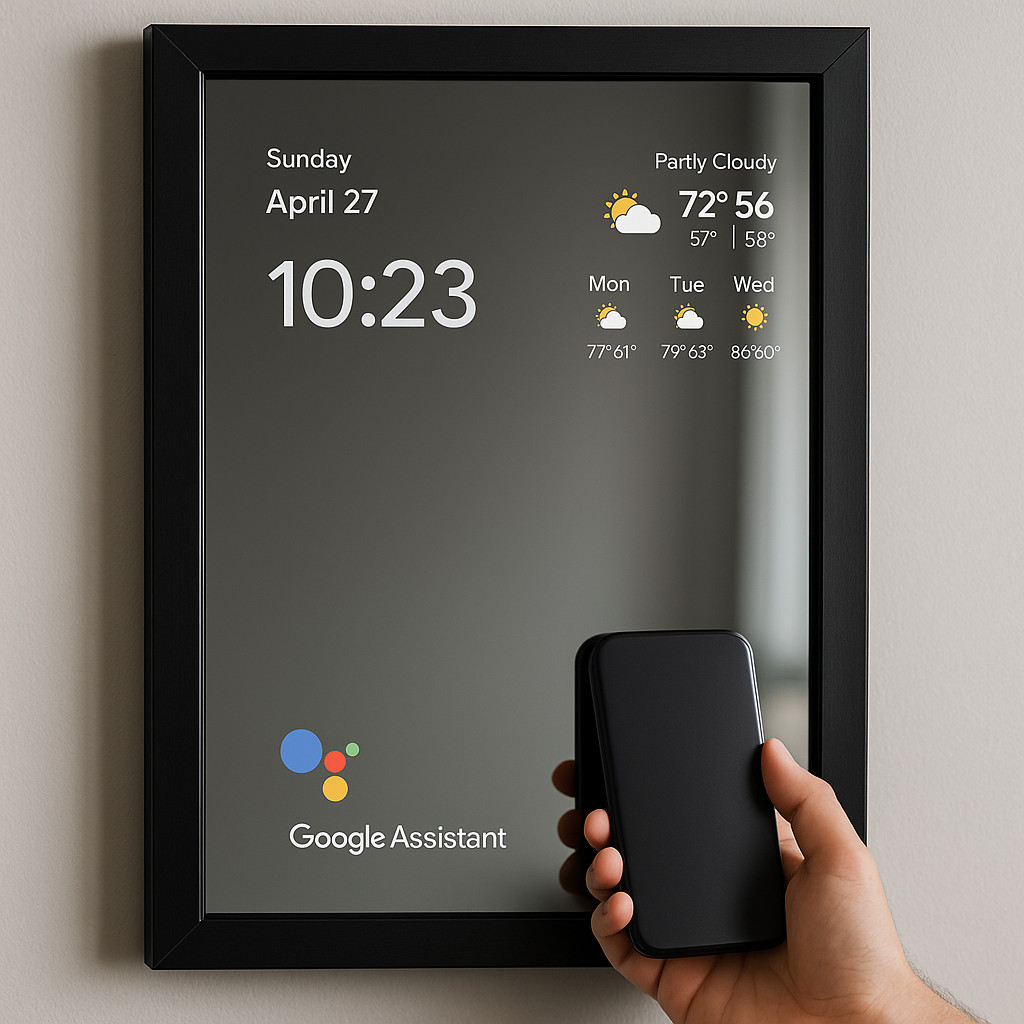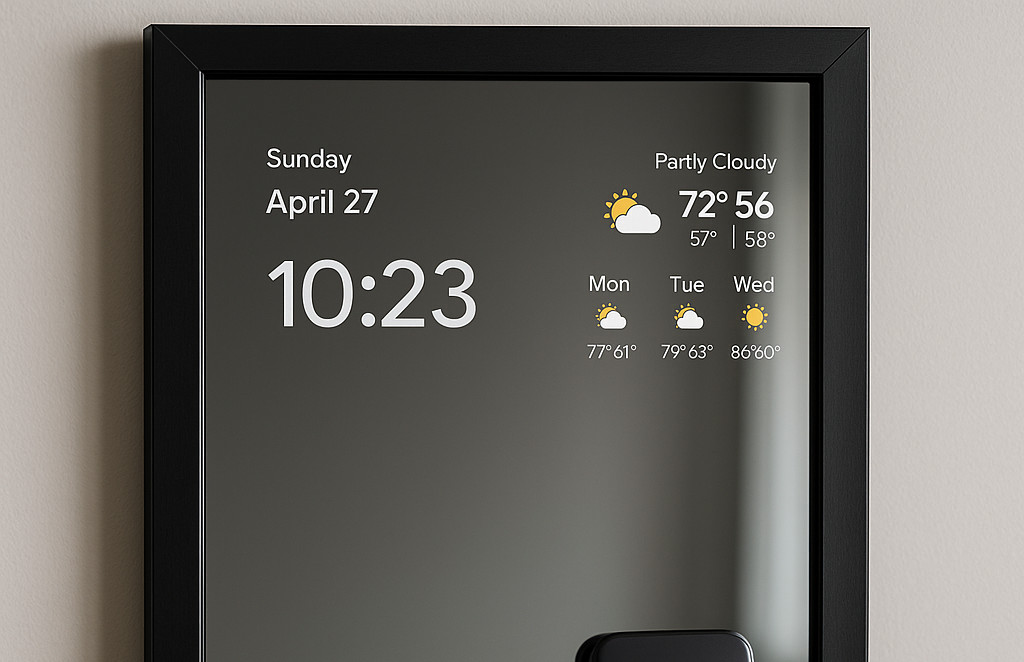In the era of connected homes and intelligent gadgets, one of the coolest and most satisfying DIY projects you can take on is building your own smart mirror. Not only is it a futuristic addition to any room, but it’s also surprisingly affordable and customizable. With just a few materials and a bit of tech tinkering, you can build a voice-activated smart mirror that displays real-time weather updates, the time, news headlines, your calendar events, and much more.
What Is a Smart Mirror?
A smart mirror is essentially a two-way mirror with a digital display behind it. When it’s off, it looks like a regular mirror, but when powered on, it can show a customizable digital interface with useful information and widgets. When integrated with voice assistants like Google Assistant or Amazon Alexa, it becomes an even more powerful hub of smart interactivity.
Materials You’ll Need
To keep the project under $100, we recommend sourcing affordable parts and using open-source software. Here’s what you’ll need:
- Raspberry Pi 3 or 4 (with microSD card and power supply)
- Old computer monitor or screen
- Two-way acrylic mirror or reflective window film
- Wood or frame for housing
- HDMI cable and connectors
- Keyboard and mouse (for setup only)
- Wi-Fi connection
Optional for voice control:
- USB microphone or microphone module
- Small speaker or Bluetooth speaker
Step-by-Step Guide
1. Set Up the Raspberry Pi
Install the latest version of Raspbian OS on your Raspberry Pi using the Raspberry Pi Imager. Connect your Pi to the monitor, keyboard, and mouse. Make sure it has internet access.
2. Install MagicMirror²
MagicMirror² is a popular open-source platform built specifically for smart mirrors. It runs on Node.js and has a wide range of modules.
To install it:
curl -sL https://deb.nodesource.com/setup_16.x | sudo -E bash -
sudo apt install -y nodejs
git clone https://github.com/MichMich/MagicMirror
cd MagicMirror
npm install
npm run startYou can configure modules such as:
- Clock
- Weather
- Calendar
- Newsfeed
- Compliments (fun messages that change during the day)
3. Build the Frame
Create or repurpose a wooden frame to house the monitor. Place the two-way acrylic mirror or reflective film over the monitor screen. Make sure everything is securely mounted and aligned.

4. Add Voice Activation (Optional)
To make your smart mirror voice-activated, integrate Google Assistant SDK or Amazon Alexa Voice Service. This may require some additional setup, but plenty of guides are available to walk you through the steps.
For Google Assistant, use the Google Assistant SDK.
For Alexa, refer to AVS Device SDK.
5. Final Touches
Mount your smart mirror on the wall or lean it on a dresser. Plug it in, and it should boot up to show your personalized dashboard. Tweak the module configurations by editing the config.js file in the MagicMirror directory.
Benefits of a Smart Mirror
- Always-On Information: Quickly check your schedule, the weather, and the news while getting ready in the morning.
- Hands-Free Assistance: With voice integration, you can get answers, play music, or control other smart devices.
- Customization: Choose what information is shown and how it’s displayed.
- Affordable and Fun: Building one costs a fraction of a commercial unit and is a satisfying tech DIY.
Pros and Cons
Pros:
- Inexpensive (especially if reusing parts)
- Fully customizable interface
- Integration with other IoT devices
- Impressively sleek and modern design
Cons:
- May require occasional troubleshooting
- Setup can be a bit technical for beginners
- Voice assistant integration takes extra steps
Final Thoughts
A DIY smart mirror is more than just a cool gadget—it’s a gateway project into the world of smart home technology and IoT. With a few simple components and some patience, you can build a mirror that not only reflects your appearance but also keeps you informed and connected.
Whether you’re a tech enthusiast, a maker, or just someone looking to spruce up your space on a budget, this project is an ideal weekend build. And the best part? It’s only the beginning. Once you start building smart devices yourself, the possibilities for customizing your home environment are endless.
- Designing a Smarter Home in 2026: What People Get Wrong About Automation
 Smart homes were once science fiction, but today they’re a reality in millions of households. With voice assistants, smart plugs, and automated lighting systems, it’s easy to assume home automation is simply a matter of plugging in a few devices. Yet, many homeowners quickly discover that “smart” doesn’t always mean simple. In this article, we’ll…
Smart homes were once science fiction, but today they’re a reality in millions of households. With voice assistants, smart plugs, and automated lighting systems, it’s easy to assume home automation is simply a matter of plugging in a few devices. Yet, many homeowners quickly discover that “smart” doesn’t always mean simple. In this article, we’ll… - Automated Online Trading: How IoT is Redefining Financial Markets
 Introduction automated online trading In a world where milliseconds can decide millions, the fusion of Internet of Things (IoT) technology and automated online trading is reshaping global finance. What once relied solely on human judgment now increasingly depends on connected machines, real-time data, and predictive algorithms. From weather sensors influencing agricultural trades to smart logistics…
Introduction automated online trading In a world where milliseconds can decide millions, the fusion of Internet of Things (IoT) technology and automated online trading is reshaping global finance. What once relied solely on human judgment now increasingly depends on connected machines, real-time data, and predictive algorithms. From weather sensors influencing agricultural trades to smart logistics… - The Role of Linux in IoT: Powering the Connected World
 The Internet of Things (IoT) is everywhere—from smart homes and wearable devices to industrial automation and self-driving cars. Behind the scenes, one operating system plays a surprisingly dominant role: Linux. Known for its stability, flexibility, and open-source nature, Linux has become the backbone of countless IoT devices and platforms. But what makes Linux so well-suited…
The Internet of Things (IoT) is everywhere—from smart homes and wearable devices to industrial automation and self-driving cars. Behind the scenes, one operating system plays a surprisingly dominant role: Linux. Known for its stability, flexibility, and open-source nature, Linux has become the backbone of countless IoT devices and platforms. But what makes Linux so well-suited… - The Smart Home Revolution in 2025: How IoT is Transforming Everyday Living
 In the past decade, the vision of a truly smart home has moved from futuristic fantasy to everyday reality. As we step into 2025, the Internet of Things (IoT) has matured into a robust ecosystem, connecting appliances, security systems, lighting, and even entertainment devices under one seamless digital roof. The result? Homes that are safer,…
In the past decade, the vision of a truly smart home has moved from futuristic fantasy to everyday reality. As we step into 2025, the Internet of Things (IoT) has matured into a robust ecosystem, connecting appliances, security systems, lighting, and even entertainment devices under one seamless digital roof. The result? Homes that are safer,… - IoT and Data Privacy: How Safe Is Your Smart Home in 2025? – IoT Security
 The smart home revolution has made everyday life more convenient than ever. From voice assistants that control the lights to security cameras that send alerts directly to your phone, connected devices have become part of our daily routines. But with this convenience comes an important question: how safe is your personal data in a world…
The smart home revolution has made everyday life more convenient than ever. From voice assistants that control the lights to security cameras that send alerts directly to your phone, connected devices have become part of our daily routines. But with this convenience comes an important question: how safe is your personal data in a world…








